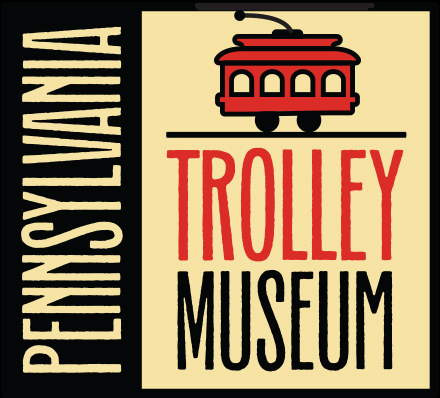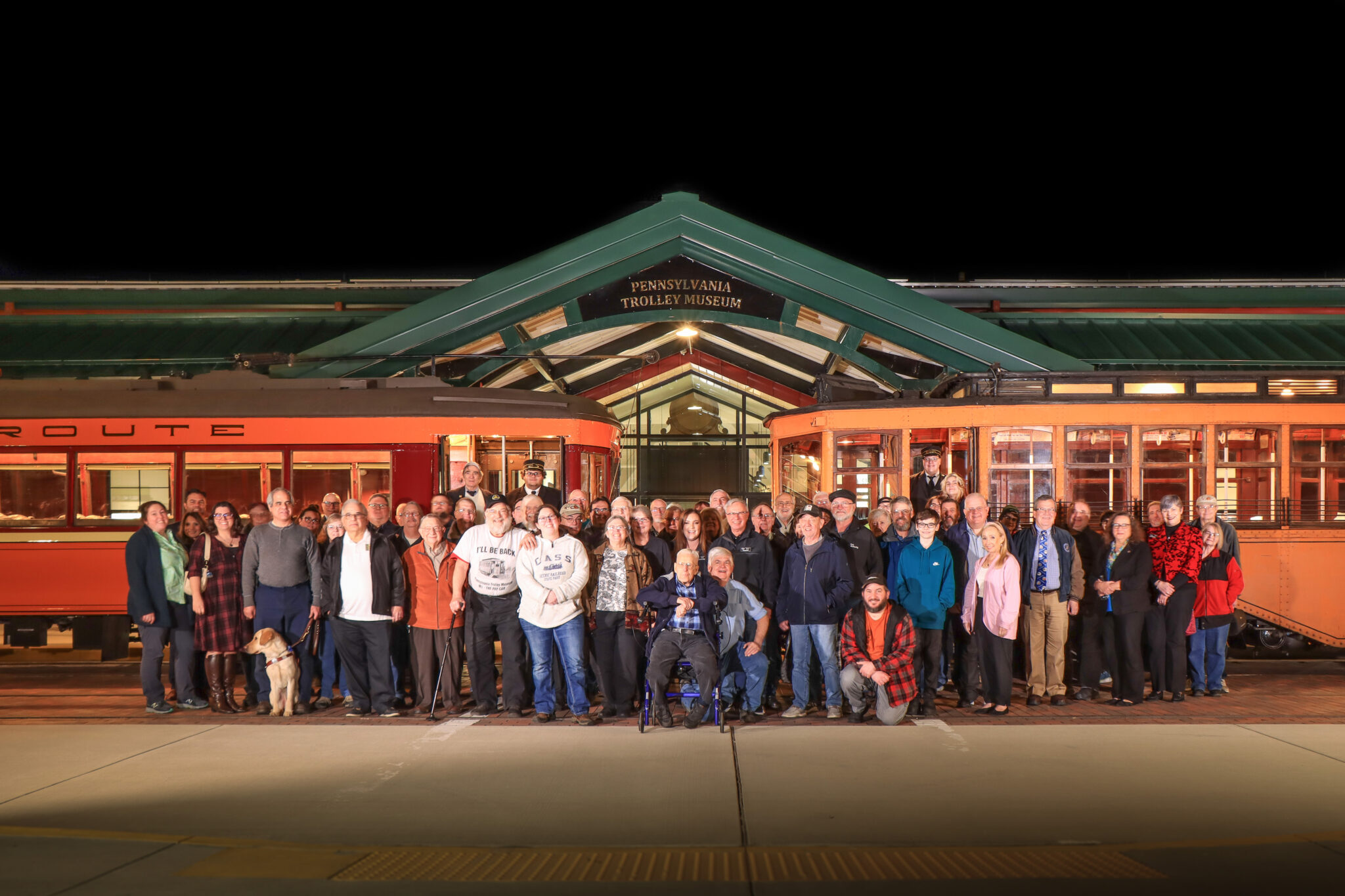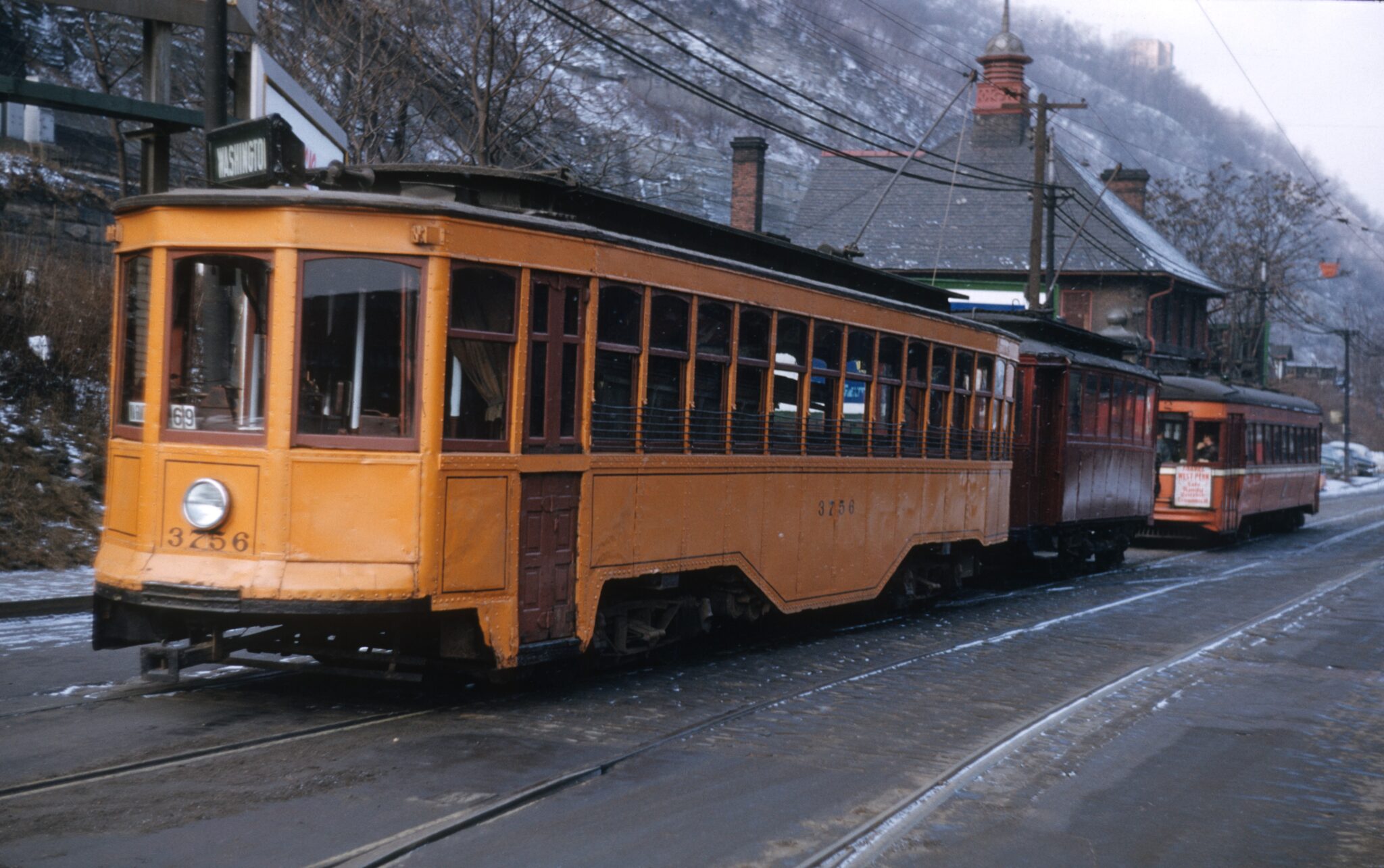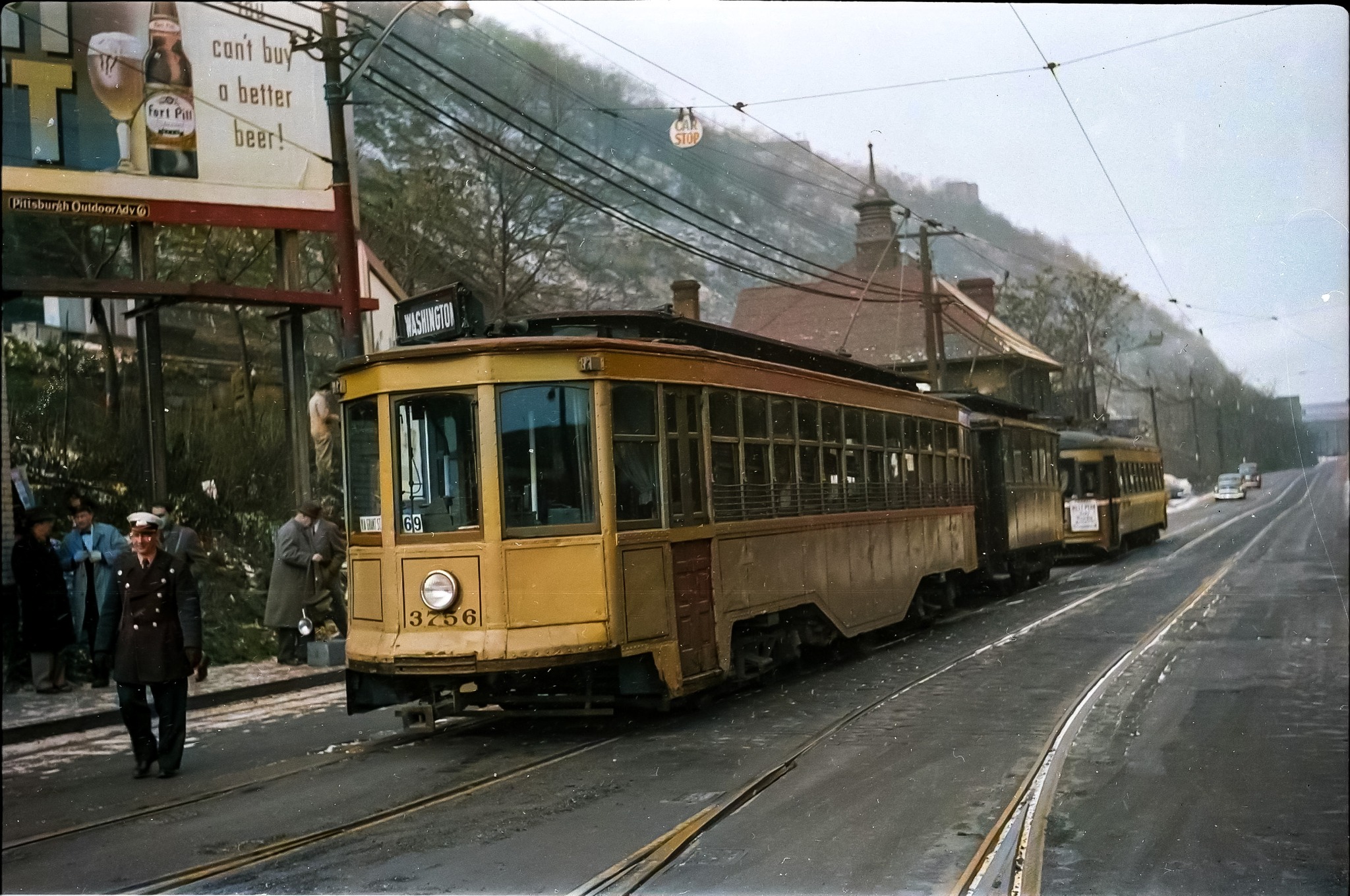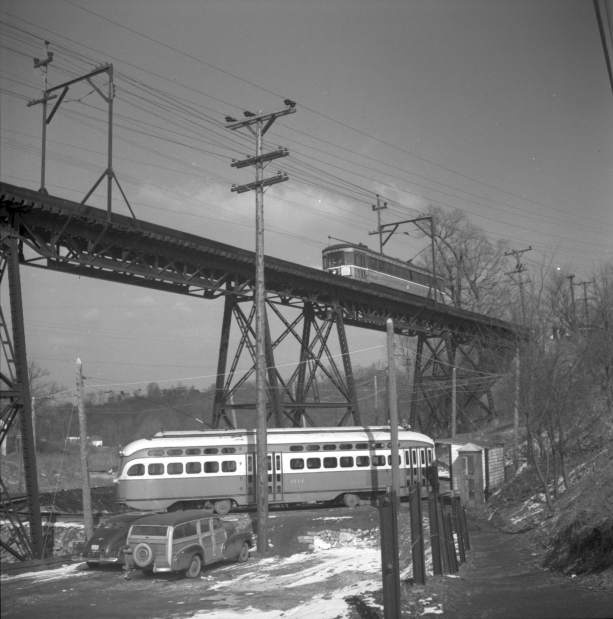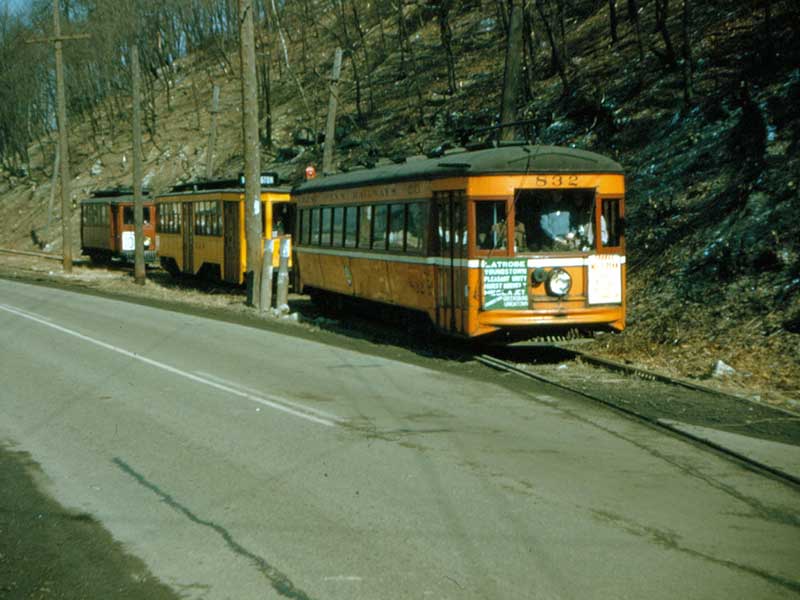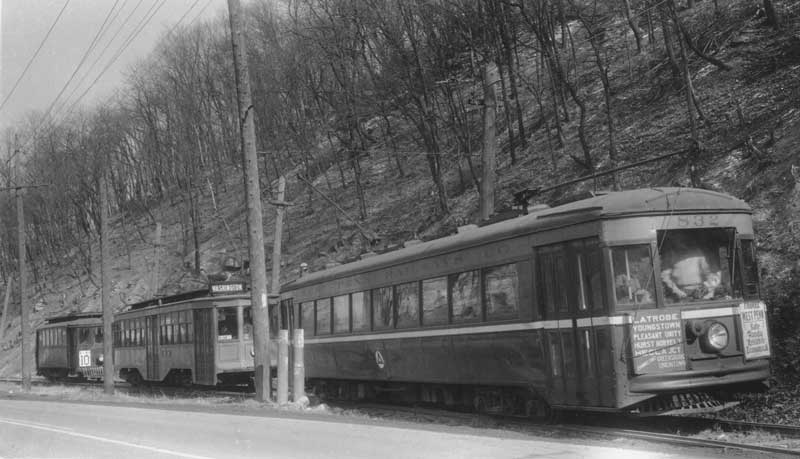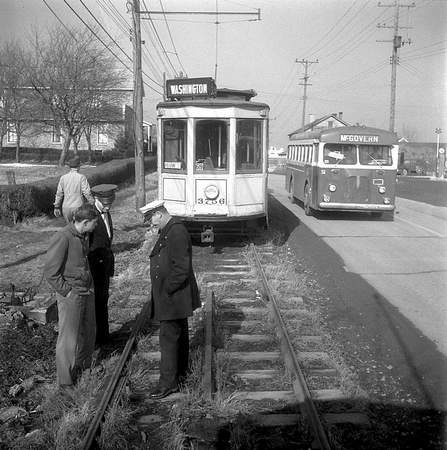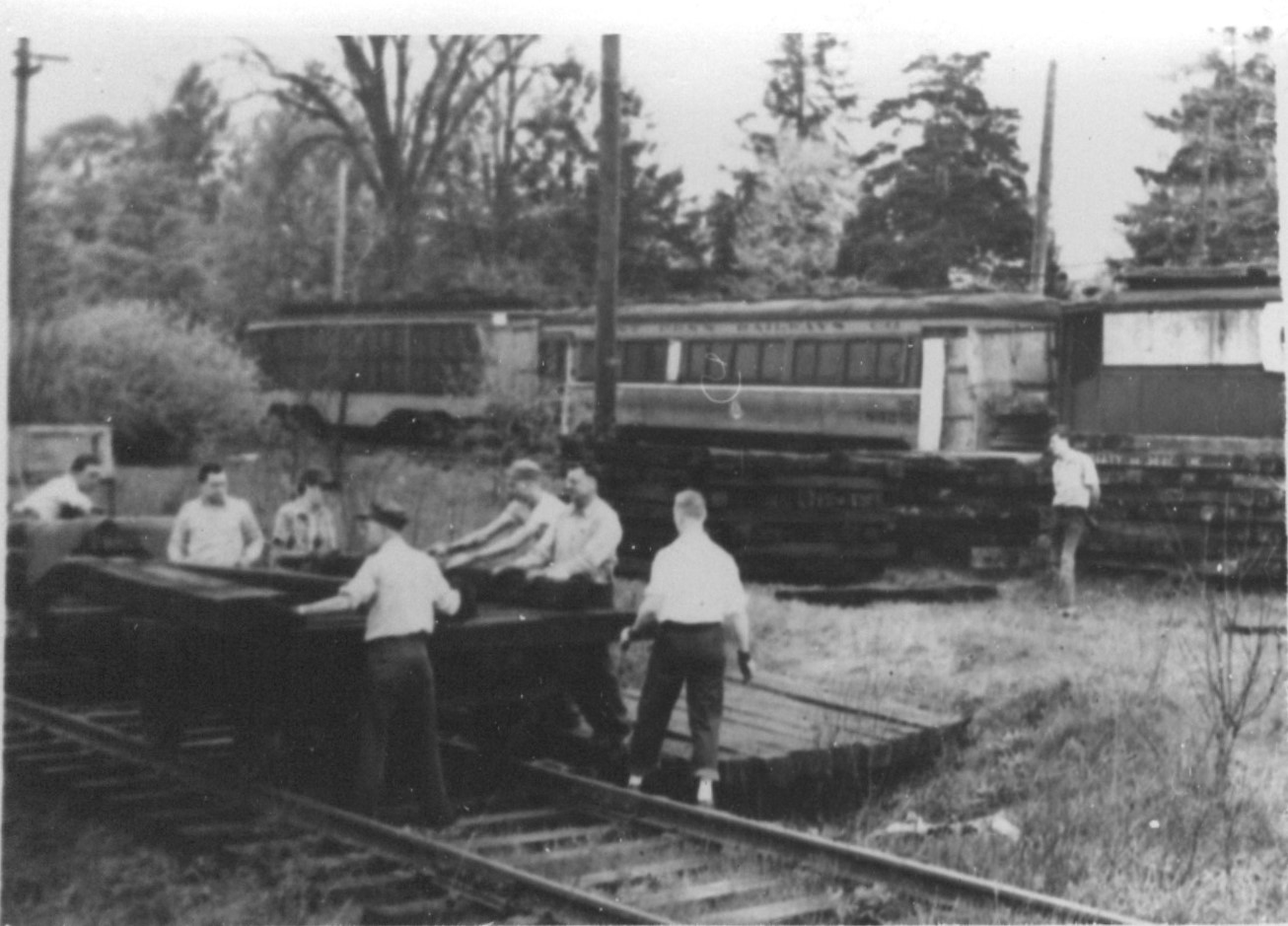Larissa Gula
On February 7, 2024, the Pennsylvania Trolley Museum (PTM) celebrated its 70th anniversary! In honor of the big day, PTM members were invited to attend a special on-site reception. After guests enjoyed cake, streetcar rides, and even an evening photoshoot, Bruce Wells presented a special Trolleyology focused on the story of the PTM, from its founding to now.
The program offered an extensive look back at 70 years of history – well, actually, at more than 70 years of history! Because while February 7 is our official founding date, our story began years before 1954.
Why We Were Founded
Our organization was founded during a period of transition. Historically, the electric streetcar played an essential role in the development of American cities. Streetcars were (relatively) quiet, fast, and clean compared to the alternatives – horses, mules, and steam engines. Their speed in particular made it possible for cities to expand beyond walking distance. As a result, cities expanded along streetcar routes; many of today’s suburban communities were built as a direct result of expanding streetcar service in the twentieth century.
Streetcars served America well through two world wars and an economic depression. Eventually, public transit could no longer compete with America’s growing love for the automobile. As public transit began to decline, groups of people began to connect over their shared desire to preserve the vanishing streetcars.
These groups faced a unique challenge – at the time, very few (if any) museums were able to preserve collections of streetcars that could be up to 60 feet long and weigh up to 50 tons. Fortunately, preservationists – including our founders – were willing to face this challenge head-on.
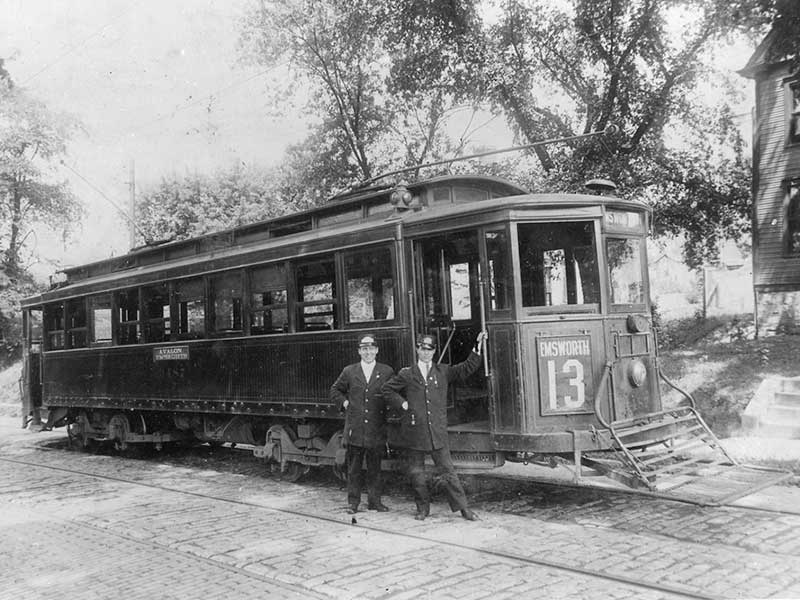
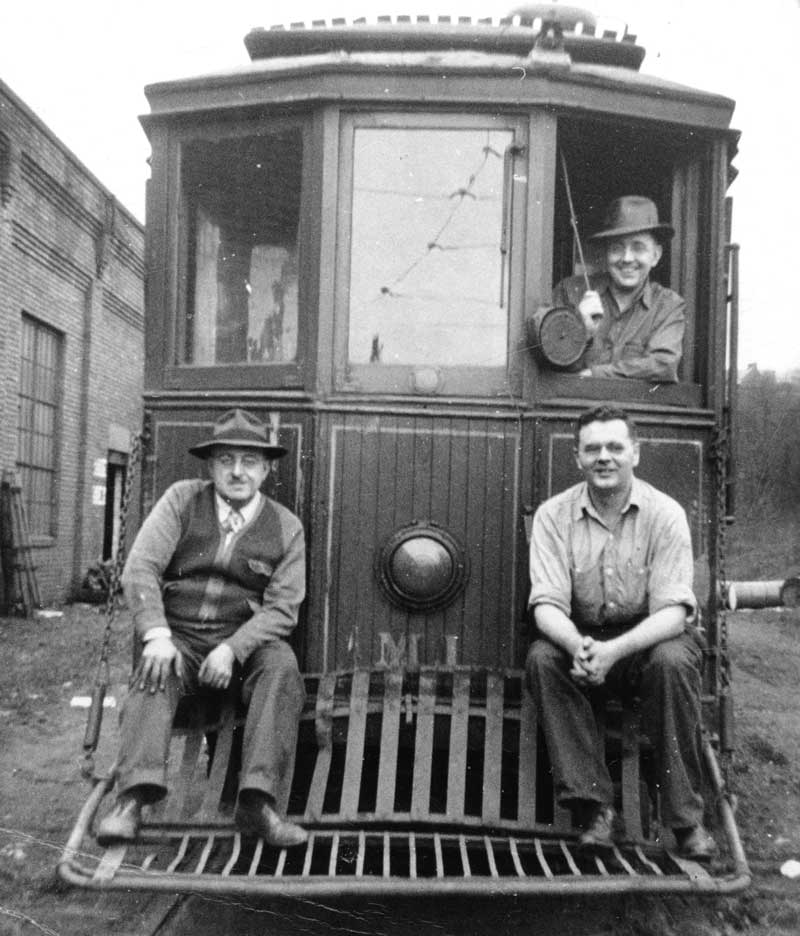
The Initial Efforts of Our Founders
While today we’re located in Washington, PA, our roots go back to the Pittsburgh area. In 1940, several members of the Pittsburgh Electric Railway Club (PERC) attempted to establish a museum in the city’s limits. The group initially acquired the body of a Pittsburgh Railways trailer car and moved it to the eastern suburbs of Pittsburgh. Members repainted the trailer and used it as their “club house” until World War II. Many members were then called to serve in the war. As a result they had to abandon the project, and the trailer was scrapped in a wartime scrap drive in 1943.
Fortunately, in 1949, another historic streetcar was acquired by the PERC: Pittsburgh Railways M1. Following the purchase, early PERC members were determined to establish a permanent home for M1 – and for the cars they intended to purchase in the future. From the start, PERC members knew they needed a location where their streetcars could be stored, maintained, and eventually displayed and operated.
Several sites on the West Penn Railways lines in Fayette and Westmoreland counties were considered but were ultimately rejected due to their distance from Pittsburgh. As these sites were evaluated, the PERC had the opportunity to purchase its second car in 1952: West Penn 832. This acquisition added to the need for the PERC to find a suitable location for its small but growing collection.
Establishing a Museum Site
In 1952, Pittsburgh Railways announced plans to abandon its interurban lines to Washington and Charleroi. For the PERC, this was good and bad news. The closure marked another milestone in the decline of transit as they knew it. However, it also meant that new locations for their museum would be available for consideration.
Ultimately, a 2,000-foot segment of the Washington line was chosen by the PERC as its “founding site.” The site was the best choice for a number of reasons:
- The chosen area included a 900-foot passing siding, and intersected with the abandoned right-of-way of a coal mine branch. These features supported the founders’ vision and goal to build tracks and extensions, allowing for demonstrations and trolley rides.
- The trackage of the selected area was also nearly level – an important consideration given the age of the antique vehicles being purchased.
- Finally, the Washington branch of the Pennsylvania Railroad paralleled the streetcar line. PERC members knew this rail connection would make it possible to receive shipments as they built their museum.
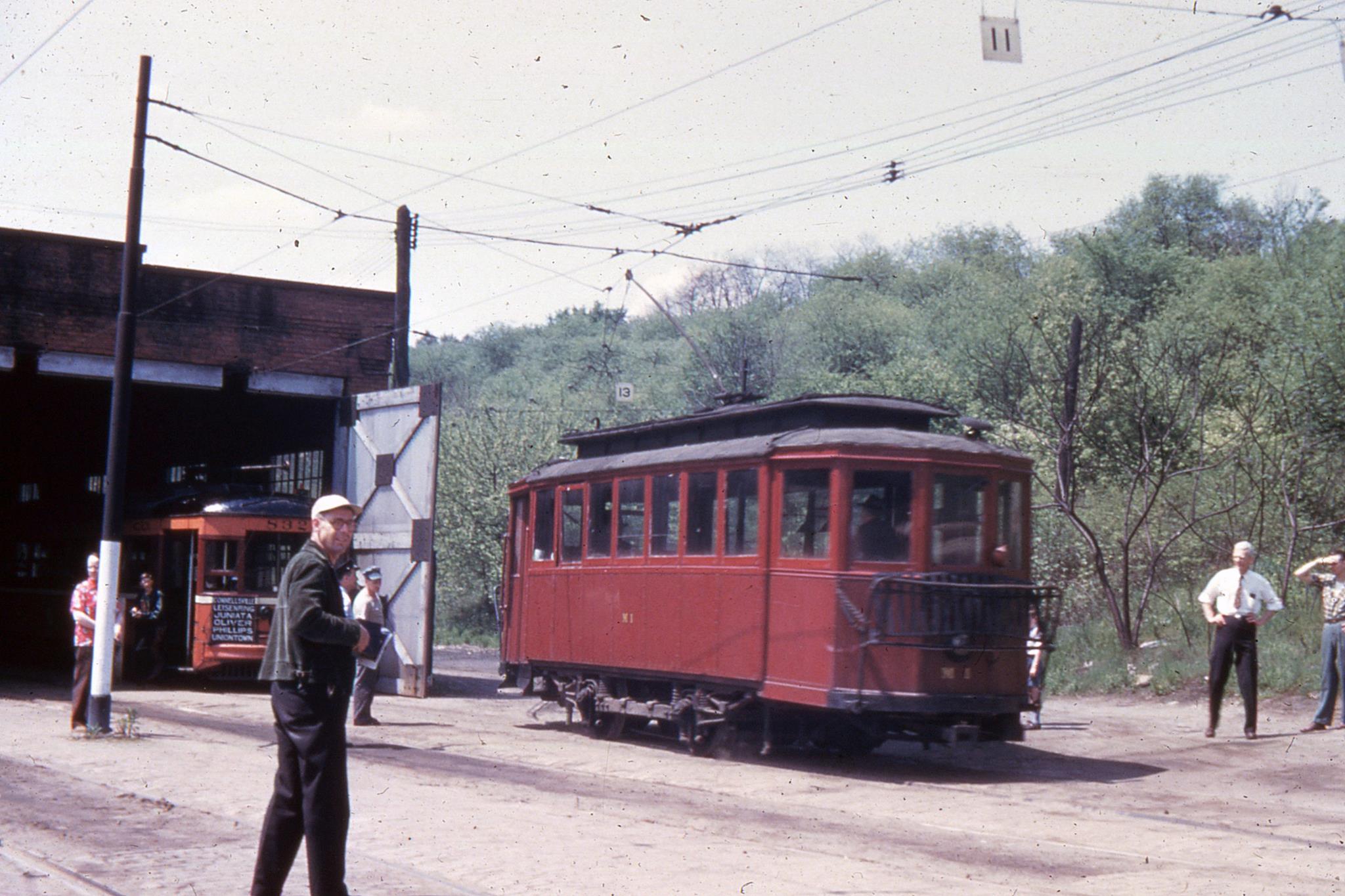
How Pittsburgh Railways Supported the Museum
At this time, Pittsburgh Railways was actually very supportive of the PERC. For example, the company was allowing M1 and 832 to be stored free of charge in Pittsburgh Railways’ car barns. PERC founders were also able to use the company’s service lines to move the car.
On May 10, 1953, a special trip was arranged to bring 832 from Charleroi (where it had been stored) to Ingram. Pittsburgh Railways’ cooperation made this and other chartered “fantrips” possible during the 1950s. However these fantrips weren’t just “for fun” – they were fundraising opportunities for the PERC’s fledgling museum, all made possible by Pittsburgh Railways.
With fundraising underway and a location in mind, the PERC moved to establish itself as a nonprofit. This new designation opened the door to issuing bonds, purchasing trackage, and preparing to construct their future museum.
The PERC also acquired its third streetcar, Pittsburgh Railways 3756, in 1953.
February 7th, 1954 – Our Official Anniversary
Five years after purchasing M1, the time came for the PERC to move out of the city limits and begin to establish itself at its new home.
On February 7, 1954, the PERC moved its three streetcars out of the city of Pittsburgh. All three cars operated under their own power from Ingram Car House to Arden (in Washington County). They were the last cars to make the trip along the Washington Interurban, and they were parked and boarded up on County Home Siding.
A fourth car was also part of the procession – it was needed to transport the crew home at the end of the day. Unfortunately, the exact number of the car has been lost to time, although we know from the stories that it was a 4300-series low-floor car.
The interurban lines that were not part of the PERC’s purchase were dismantled shortly after the move.
Building a Public-Facing Museum
While February 7 is considered our “founding date” it would be almost another decade before the PERC opened its museum to the public. Lots of work was needed before an opening day could be set.
In the 1950s, the PERC began to develop the “Arden Electric Railway” (as we were originally known). In 1955, the PERC focused on acquiring the track and materials needed to build a proper car barn. Second-hand ties were acquired from the Pennsylvania Railroad and delivered to Arden Station; then a motor car and trailer were used to secure and transfer the ties to the worksite.
Switches and rails were laid out to form a three-track “ladder” for the building. Plans were prepared for the construction of the barn, and in June 1957 the group’s Directors authorized a motion in support of the fundraising, poles, bolts, and construction needed to build the carbarn.
Work on the Arden Electric Railway and the barn was slow going, as most volunteers could only convene and work together on weekends. During building sessions, they would bring track tools in the trunks of their cars and work until the sun set.
Work was also slow going because even if the labor was being given voluntarily, materials were another matter. Fortunately, a very active fantrip schedule provided the proceeds necessary to construct the carbarn. Of course, PERC members were often overseeing these fantrips; therefore, fantrips were both a necessity and a roadblock to working on the barn.
The carbarn was constructed by hand between 1957 and 1961. Upon completion, the 143-foot-long building gave the Arden Electric Railway the distinction (at the time) of being the only trolley museum to have its entire collection stored indoors.
An Expanding Collection
Because they just weren’t busy enough running fantrips and building the first carbarn, PERC members were also actively looking for streetcars to acquire during this time period.
Pittsburgh Railways 3487 and Pittsburgh Railways 4398 were both acquired in 1956. Pittsburgh Railways generously supported the purchase once again, this time by allowing the PERC to store the cars at Glenwood Car House until 1960. This in turn allowed 3487 and 4398 to be used in several fundraising fantrips, including an extensive one arranged in conjunction with the National Model Railroaders’ Convention in 1958.
Then, in 1957, Philadelphia Rapid Transit 5326 became the first car to be purchased from outside of Pittsburgh. The car couldn’t be transported until 1958, when it became the first streetcar to travel on the Pennsylvania Turnpike.
Other acquisitions included West Penn Locomotive 1 in 1958, and Johnstown Traction Company 350 in September 1959.
…and That Was Just the Beginning!
Incredibly, all of the work, memories, and events we’ve recounted thus far took place in the 1940s and 1950s – just two decades out of our lengthy history! The time and dedication of our founders is certainly evident from the very start and founding of the Pennsylvania Trolley Museum. As we celebrate our 70th anniversary this year, we’ll be honoring the people and the efforts that made our current visitor experience possible.
Throughout 2024, we plan to look back on additional memories and milestones at the Pennsylvania Trolley Museum. In the meantime, we invite you to watch Bruce Wells’ Trolleyology presentation if you haven’t already. His excellent presentation includes additional memories, details, and photographs that we couldn’t include here!
